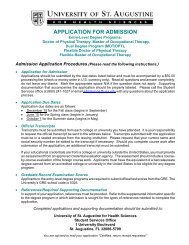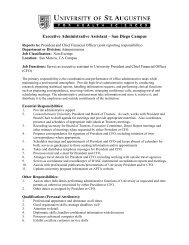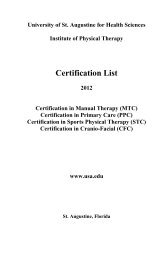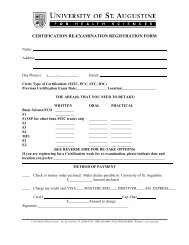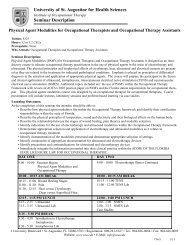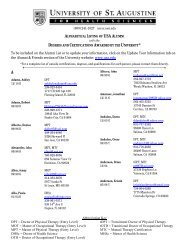COURSE DESCRIPTIONSPrefix key:BSC – Basic sciencesCOM – CommunicationsEDF – EducationHAS – <strong>Health</strong> services administrationHSC – <strong>Health</strong> sciencesIDS – Independent <strong>St</strong>udyOCT – Occupational TherapyOPA – Orthopaedic Physician AssistantPHT – Physical TherapyPSY - PsychologyBSC 6001E – Foundations <strong>of</strong> Clinical Orthopaedics Hours: 2This is an online self-study course discussing the foundations <strong>of</strong> orthopaedics and manipulative therapy.The history and development <strong>of</strong> orthopaedics and specifically manual therapy are explored. Arthrologyand biomechanics are discussed, with special attention to tissue biomechanics and arthrokinematics.Emphasis is placed on spinal anatomy and movement. The <strong>University</strong>'s philosophy <strong>of</strong> examination,treatment, and pain management is introduced but attention is also given to other diagnostic classificationsystems. Classifications and indications <strong>for</strong> manipulation are reviewed. The course provides anintroduction to the evidence-in<strong>for</strong>med clinical practice paradigm teaching the student to combine varioussources <strong>of</strong> knowledge in the diagnosis, prognosis, and management <strong>of</strong> orthopaedic dysfunctions.BSC 6001 - Foundations <strong>of</strong> Clinical Orthopaedics Hours: 2This is an online self-study course discussing the foundations <strong>of</strong> orthopaedics and manipulative therapy.The history and development <strong>of</strong> orthopaedics and specifically manual therapy are explored. Arthrologyand biomechanics are discussed, with special attention to tissue biomechanics and arthrokinematics.Emphasis is placed on spinal anatomy and movement. The <strong>University</strong>'s philosophy <strong>of</strong> examination,treatment, and pain management is introduced but attention is also given to other diagnostic classificationsystems. Classifications and indications <strong>for</strong> manipulation are reviewed. The course provides anintroduction to the evidence-in<strong>for</strong>med clinical practice paradigm teaching the student to combine varioussources <strong>of</strong> knowledge in the diagnosis, prognosis, and management <strong>of</strong> orthopaedic dysfunctions.BSC 6101E – Application <strong>of</strong> Motor Control and Motor LearningTheory to Neurological Intervention Hours: 2In this course the student will examine current research and theories in motor control and motor learningand their relationship to examination and intervention in patients with neurologic dysfunction. <strong>St</strong>udentswill examine neuroanatomical structures, functions, and neuroplasticity <strong>of</strong> the nervous system as theyrelate to motor control tasks. Specific motor control issues in balance, gait, and upper extremity areexamined and discussed. <strong>St</strong>udents will identify and explain the influence <strong>of</strong> impairments on motordysfunction and a patient’s motor control. The course is open to both physical and occupational therapystudents or clinicians.BSC 6101 - Application <strong>of</strong> Motor Control and Motor LearningTheory to Neurologic Intervention Hours: 2In this online course the student will examine current research and theories in motor control and motorlearning and their relationship to examination and intervention in patients with neurologic dysfunction.<strong>St</strong>udents will examine neuroanatomical structures, functions, and neuroplasticity <strong>of</strong> the nervous systemas they relate to motor control tasks. Specific motor control issues in balance, gait, and upper extremityare examined and discussed. <strong>St</strong>udents will identify and explain the influence <strong>of</strong> impairments on motordysfunction and a patient’s motor control.86
BSC 6102E – Interventions <strong>for</strong> the Older Adult with aNeurological Impairment Hours: 3The student will discuss issues and interventions concerning the older adult client/patient with aneurologic impairment. Topics include the impact <strong>of</strong> aging on the nervous system, innovations inmedical management <strong>for</strong> neurologic conditions, OT/PT interventions <strong>for</strong> motor learning, balance, falls,assistive technology and client/patient centered education programs. Current literature will be used todevelop evidence-based treatment programs that impact function.BSC 6102 - Interventions <strong>for</strong> the Older Adult with a Hours: 3Neurological ImpairmentThe student will discuss issues and interventions concerning the older adult client/patient with aneurologic impairment. Topics include the impact <strong>of</strong> aging on the nervous system, innovations inmedical management <strong>for</strong> neurologic conditions, OT/PT interventions <strong>for</strong> motor learning, balance, falls,assistive technology and client/patient centered education programs. Current literature will be used todevelop evidence-based treatment programs that impact function.BSC 6103E – The Pediatric Client with a Neurological Impairment Hours: 3The goal <strong>of</strong> the seminar is to provide participants with advanced knowledge and application <strong>of</strong> skilledobservation and intervention <strong>for</strong> the special needs <strong>of</strong> the pediatric client with a neurological impairment.The lecture component will include updates on treatment approaches used in pediatric intervention(motor learning and control theory, neurodevelopmental principles (NDT), my<strong>of</strong>ascial release treatmentprinciples, oral motor treatment, positioning, strengthening, and other treatment techniques) with anemphasis on evidenced based practice. During the lab component, participants will apply NDT,my<strong>of</strong>ascial release, strengthening, and other techniques to facilitate functional skills in infants andchildren with congenital and acquired movement disorders.BSC 6103 -The Pediatric Client with a Neurological Impairment Hours: 3The goal <strong>of</strong> the seminar is to provide participants with advanced knowledge and application <strong>of</strong> skilledobservation and intervention <strong>for</strong> the special needs <strong>of</strong> the pediatric client with a neurological impairment.The lecture component will include updates on treatment approaches used in pediatric intervention(motor learning and control theory, neurodevelopmental principles (NDT), my<strong>of</strong>ascial release treatmentprinciples, oral motor treatment, positioning, strengthening, and other treatment techniques) with anemphasis on evidenced based practice. During the lab component, participants will apply NDT,my<strong>of</strong>ascial release, strengthening, and other techniques to facilitate functional skills in infants andchildren with congenital and acquired movement disorders.BSC 6200 – Evidence-Based Research <strong>for</strong> the <strong>Health</strong> Pr<strong>of</strong>essional Hours: 3The amount <strong>of</strong> research available to the physical and occupational therapist upon which to base clinicaldecision-making with regard to diagnosis, prognosis, and management has multiplied tremendously overthe last 20 years. Within the currently predominant paradigm <strong>of</strong> evidence-based practice, every therapistneeds to be able to critically evaluate the evidence available prior to application into clinical practice.The Evidence-Based Research course is an introduction to research methods, psychometric properties <strong>of</strong>tests and measures as used in the clinical situation <strong>for</strong> diagnosis, prognosis, and assessment <strong>of</strong> outcomeand risk <strong>of</strong> harm, clinical prediction rules and clinical practice guidelines, sampling, experimental design,statistics, literature review, evidence-based practice, research models, and conducting article critiques.The purpose <strong>of</strong> this course is to enhance inquiry skills from both multicultural and multi-pr<strong>of</strong>essionalviewpoints. The main emphasis <strong>of</strong> this course is to allow the students to become critical consumers <strong>of</strong> the87
- Page 4 and 5:
San Diego sunsetSt. Augustine and o
- Page 6 and 7:
STUDENT SERVICES ..................
- Page 8 and 9:
DOCTOR OF EDUCATION (EdD) .........
- Page 10 and 11:
San Marcos, California CampusSt. Au
- Page 12 and 13:
certification. A felony conviction
- Page 14 and 15:
In 1996, the Institute of Occupatio
- Page 16 and 17:
Learning Resource CenterThe Univers
- Page 18 and 19:
ENTRY-LEVEL PHYSICAL THERAPY, OCCUP
- Page 20 and 21:
SUMMER 2012 TRIMESTERApril 30Intern
- Page 22 and 23:
TRANSITONAL DOCTOR OF PHYSICAL THER
- Page 24 and 25:
BOARD OF TRUSTEESMr. Joseph Taylor,
- Page 26 and 27:
• Graduate Record Examination sco
- Page 28 and 29:
• The right to inspect and review
- Page 30 and 31:
San Marcos Campus: The full-time DP
- Page 32 and 33:
Transitional Doctor of Physical The
- Page 34 and 35:
Scholarships are awarded to the ent
- Page 36 and 37:
San Marcos Campus - The entry-level
- Page 38 and 39:
Director, will determine if the sub
- Page 40 and 41:
The student obtains and submits the
- Page 42 and 43:
Good Academic Standing StatusPrior
- Page 44 and 45:
Appeal letters should address:• T
- Page 46 and 47: TUITION AND FEESThe University of S
- Page 48 and 49: Currently enrolled students who are
- Page 50 and 51: TRIMESTER IITrimester HoursHSC 5122
- Page 52 and 53: TRIMESTER IITrimester HoursHSC 5122
- Page 54 and 55: Dual Degree Option (MOT and DPT)The
- Page 56 and 57: TRIMESTER IXTrimester HoursPHT 5824
- Page 58 and 59: Mission StatementThe mission of the
- Page 60 and 61: TRIMESTER XTrimester HoursPHT 5140C
- Page 62 and 63: TRIMESTER IITrimester HoursHSC 5122
- Page 64 and 65: TRANSITIONAL DOCTOR OF OCCUPATIONAL
- Page 66 and 67: Delivery of transitional OTD Course
- Page 68 and 69: BSC 6101 Application of Motor Contr
- Page 70 and 71: TRANSITIONAL DOCTOR OF OCCUPATIONAL
- Page 72 and 73: Delivery of OTD CourseworkCourses i
- Page 74 and 75: Advanced Practice CoursesBSC 6001 F
- Page 76 and 77: TRANSITIONAL DOCTOR OF PHYSICAL THE
- Page 78 and 79: • For the speciality clinical tra
- Page 80 and 81: Craniofacial TrackCourse # Course T
- Page 82 and 83: TRANSITIONAL DOCTOR OF PHYSICAL THE
- Page 84 and 85: • If a Clinical Residency is chos
- Page 86 and 87: Craniofacial TrackCourse # Course T
- Page 88 and 89: DIVISION OF POST-PROFESSIONAL STUDI
- Page 90 and 91: Complete a minimum of one (1) cours
- Page 92 and 93: TUITION AND FEES - Doctor of Health
- Page 94 and 95: A credentialing evaluation from an
- Page 98 and 99: scientific literature needed to gui
- Page 100 and 101: EDF 7125 - Organizational Leadershi
- Page 102 and 103: HSA 6101E - Health Services Adminis
- Page 104 and 105: In addition, the course will addres
- Page 106 and 107: individual reasoning and acquired k
- Page 108 and 109: HSC 7300 - Imaging for Physical and
- Page 110 and 111: OCT 5005 - Clinical Reasoning Hour:
- Page 112 and 113: OCT 5802 - Fieldwork IA Hour: 1This
- Page 114 and 115: OCT 6497 - Capstone Project 2 Hours
- Page 116 and 117: Assignments and course work will em
- Page 118 and 119: elective area of orthopaedic examin
- Page 120 and 121: learning, and skill acquisition. Ne
- Page 122 and 123: PHT 5805 - Practicum II Hours: 2Thi
- Page 124 and 125: anatomical principles for the enhan
- Page 126 and 127: sixth day. Prerequisites are BSC 60
- Page 128 and 129: practice where they will have the o
- Page 130 and 131: DIVISION OF PROFESSIONAL EDUCATIONC
- Page 132 and 133: Sports Physical Therapy Certificati
- Page 134 and 135: Advance Payment ProgramThe Advance
- Page 136 and 137: CLINICAL ORTHOPAEDIC RESIDENCYThe u
- Page 138 and 139: ORTHOPAEDIC MANUAL PHYSICAL THERAPY
- Page 140 and 141: FACULTY FOR CONTINUING PROFESSIONAL
- Page 142 and 143: Robert Stanborough, PT, Assistant P
- Page 144 and 145: Matthew Daugherty, PT, OTR/L, Instr
- Page 146 and 147:
Marcia Kessack, RN, Adjunct Faculty
- Page 148 and 149:
Marilyn Miller, PT, Associate Profe
- Page 150 and 151:
Robert Stanborough, PT, Assistant P
- Page 152:
Clinical ExcellenceThrough Graduate



